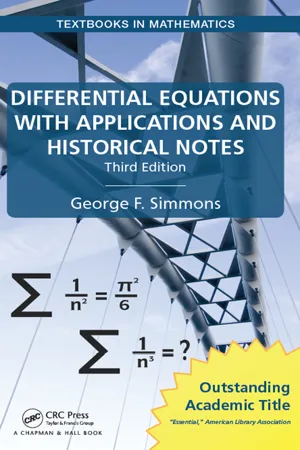
- 764 pages
- English
- ePUB (mobile friendly)
- Available on iOS & Android
Differential Equations with Applications and Historical Notes
About this book
Fads are as common in mathematics as in any other human activity, and it is always difficult to separate the enduring from the ephemeral in the achievements of one's own time. An unfortunate effect of the predominance of fads is that if a student doesn't learn about such worthwhile topics as the wave equation, Gauss's hypergeometric function, the gamma function, and the basic problems of the calculus of variations—among others—as an undergraduate, then he/she is unlikely to do so later.
The natural place for an informal acquaintance with such ideas is a leisurely introductory course on differential equations. Specially designed for just such a course, Differential Equations with Applications and Historical Notes takes great pleasure in the journey into the world of differential equations and their wide range of applications. The author—a highly respected educator—advocates a careful approach, using explicit explanation to ensure students fully comprehend the subject matter.
With an emphasis on modeling and applications, the long-awaited Third Edition of this classic textbook presents a substantial new section on Gauss's bell curve and improves coverage of Fourier analysis, numerical methods, and linear algebra. Relating the development of mathematics to human activity—i.e., identifying why and how mathematics is used—the text includes a wealth of unique examples and exercises, as well as the author's distinctive historical notes, throughout.
- Provides an ideal text for a one- or two-semester introductory course on differential equations
- Emphasizes modeling and applications
- Presents a substantial new section on Gauss's bell curve
- Improves coverage of Fourier analysis, numerical methods, and linear algebra
- Relates the development of mathematics to human activity—i.e., identifying why and how mathematics is used
- Includes a wealth of unique examples and exercises, as well as the author's distinctive historical notes, throughout
- Uses explicit explanation to ensure students fully comprehend the subject matter
Outstanding Academic Title of the Year, Choice magazine, American Library Association.
Frequently asked questions
- Essential is ideal for learners and professionals who enjoy exploring a wide range of subjects. Access the Essential Library with 800,000+ trusted titles and best-sellers across business, personal growth, and the humanities. Includes unlimited reading time and Standard Read Aloud voice.
- Complete: Perfect for advanced learners and researchers needing full, unrestricted access. Unlock 1.4M+ books across hundreds of subjects, including academic and specialized titles. The Complete Plan also includes advanced features like Premium Read Aloud and Research Assistant.
Please note we cannot support devices running on iOS 13 and Android 7 or earlier. Learn more about using the app.
Information
Chapter 1
The Nature of Differential Equations. Separable Equations
1 Introduction
(1) |
(2) |
(3) |
(4) |
(5) |
(6) |
(7) |
(8) |
(9) |
Table of contents
- Cover
- Half Title
- Series Page
- Title Page
- Copyright Page
- Dedication
- Table of Contents
- Preface to the Third Edition
- Preface to the Second Edition
- Preface to the First Edition
- Suggestions for the Instructor
- About the Author
- 1. The Nature of Differential Equations. Separable Equations
- 2. First Order Equations
- 3. Second Order Linear Equations
- 4. Qualitative Properties of Solutions
- 5. Power Series Solutions and Special Functions
- 6. Fourier Series and Orthogonal Functions
- 7. Partial Differential Equations and Boundary Value Problems
- 8. Some Special Functions of Mathematical Physics
- 9. Laplace Transforms
- 10. Systems of First Order Equations
- 11. Nonlinear Equations
- 12. The Calculus of Variations
- 13. The Existence and Uniqueness of Solutions
- 14. Numerical Methods
- Numerical Tables
- Answers
- Index